 Download PDF
Download PDF
Name: Cuscuta gronovii Willd. ex Schultes
Family: Convolvulaceae, the Morning Glory Family (8) or Cuscutaceae, the Dodder Family (9)
Common Names: Swamp Dodder (1), Scaldweed (3), Common Dodder (4), Love Dodder (6)
Etymology: Cuscuta is derived from Arabic for the genus of all dodders; gronovii is in honor of Jan Fredrik Gronon (1690-1762) (6). The common name, dodder, may originate from Middle English “daderen” meaning to quake or tremble (1483), from the word dade, or a form similar to totter or patter (16).
Botanical Synonyms:
Cuscuta umbrosa auct. non Beyr. ex Hook.
Grammica gronovii (Willd. ex Roem. & Schult) Hadac & Chrtek
Grammica umbrosa auct. non (Beyr. ex Hook.) W.A.Weber (6)
Quick Notable Features (1,4,12,18):
¬ Flowers are glandular toward the apex of the ovary, occasionally with orange-yellow spots
¬ Orange-yellow stems, twining left to right
¬ Leaves are only scales
¬ Looks like a tangled mass of yellow netting on host plants
Plant Height: Normally to 2m long, but it has been reported to reach half a mile long (4, 6, 18).
Subspecies/varieties recognized (6, 7):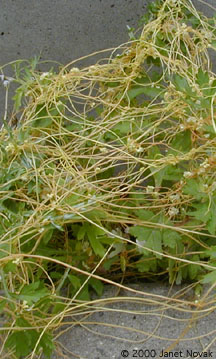
Cuscuta gronovii Willd. ex Schult. var. calyptrata Engelm.
Cuscuta gronovii Willd. ex Schult. var. gronovii
Cuscuta gronovii Willd. ex Roem. & Schult. var. latiflora Engelm.
Cuscuta gronovii Willd. ex Roem. & Schult. var. saururi (Engelm.) MacMill.
Most Likely Confused with: C. gronovii can be confused with other members of the genus Cuscuta, and possibly with members of the Polygonaceae that climb, such as Persicaria and Fallopia. Cuscuta may also be confused with Morning Glories, the genera Ipomoea and Convolvulus, which are other members of the Convolvulaceae (1).
Habitat Preference: Cuscuta gronovii is found in damp thickets, meadows, and roadsides (4).
Geographic Distribution in Michigan: The species is mainly found in mid- to southern Michigan (32 counties in the lower peninsula), but it is also found in Manistee and Benzie counties. Cuscuta gronovii is also found in Menominee county in the upper peninsula (1).
Known Elevational Distribution: The species is found in lowlands up to 200 m above sea level (11, 15).
Complete Geographic Distribution: C. gronovii is found in most of the continental USA (AL, AR, AZ, CO, CT, DC, DE, FL, GA, IA, ID, IL, IN, KS, KY, LA, MA, MD, ME, MI, MN, MO, MS, MT, NC, ND, NE, NH, NJ, NM, NY, OH, OK, OR, PA, RI, SC, SD, TN, TX, VA, VT, WI, WV, WY), and Canada (AB, MB, NB, NS, ON, PE, QC, SK) (3,7). It has been naturalized in many places in central Europe, such as France, Germany, Luxemburg, Italy, and the Netherlands (14, 20).
Parasitism: Parasitism is a type of symbiotic relationship in which plants obtain nutrients directly from another plant. Although parasitic plants are commonly known to lack chlorophyll, some species have green organs, making them partially autotrophic. The physical link between the parasite and the host is called a “haustorium”, and often occurs through xylem-to-xylem attachment. The host can vary, ranging from the mycorrhizae of trees, to grasses and hardwood trees. The parasite often maintains open or partially open stomata, allowing transpiration to aid in extracting nutrients from the host (23).
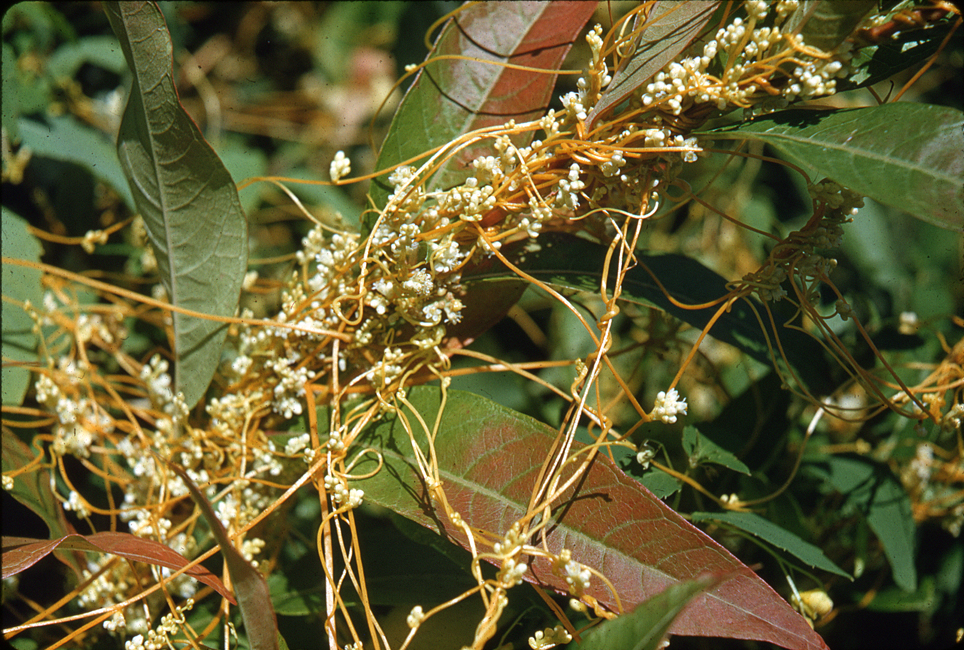 Vegetative Plant Description: The stem of C. gronovii is orange-yellow, smooth, and about 2mm thick (12). The scale-like leaves are alternate on the stem. Once C. gronovii attaches to a host, the parasitic plant no longer needs roots (17). Once the plant has established at least one haustorial contact with the host plant, the roots of the parasite wither (18). The haustoria of C. gronovii penetrate the tissue of the host plant, which allows for withdrawal of nutrients from the host. Cuscuta spp. thrives on the phloem of other species (19). These plants have the capability of both photosynthesizing and of relying solely on a host plant (17), as evidenced by the presence of some stomata on the stem of the plant (18). There are traces of chlorophyll in C. gronovii, but the photosynthetic activity is determined mainly by external factors such as sunlight (17), and the species shows photosynthetic activity when in high light (21). This parasitic plant has a large range of host preferences, although it shows a preference for taller plants. Main hosts include species of the genera Euthamia, Cyperus, Aster, Rubus, Lysmachia, Panicum, Poa, Acer, Smilax, and Vaccinium (21).
Vegetative Plant Description: The stem of C. gronovii is orange-yellow, smooth, and about 2mm thick (12). The scale-like leaves are alternate on the stem. Once C. gronovii attaches to a host, the parasitic plant no longer needs roots (17). Once the plant has established at least one haustorial contact with the host plant, the roots of the parasite wither (18). The haustoria of C. gronovii penetrate the tissue of the host plant, which allows for withdrawal of nutrients from the host. Cuscuta spp. thrives on the phloem of other species (19). These plants have the capability of both photosynthesizing and of relying solely on a host plant (17), as evidenced by the presence of some stomata on the stem of the plant (18). There are traces of chlorophyll in C. gronovii, but the photosynthetic activity is determined mainly by external factors such as sunlight (17), and the species shows photosynthetic activity when in high light (21). This parasitic plant has a large range of host preferences, although it shows a preference for taller plants. Main hosts include species of the genera Euthamia, Cyperus, Aster, Rubus, Lysmachia, Panicum, Poa, Acer, Smilax, and Vaccinium (21).
Climbing Mechanism: Upwardly twining only, from left to right (5,18).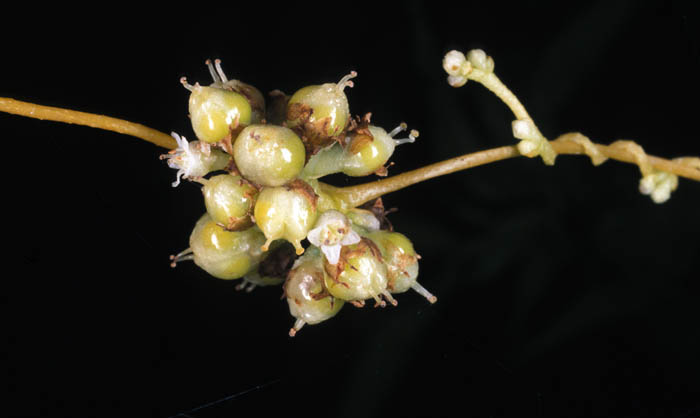
Flower Description: The cymose inflorescence contains 6 – 18 flowers (12). Each flower is white, with or without glands, about 2.2 to 4.2 mm long, five-merous, with both calyx and corolla present and connate (1, 5). The corolla tube is longer than the calyx. Five rounded, apically warty petals are present in each flower (1, 6). The five stamens bear scales positioned opposite the stamens and alternate with the petals. The staminal scales are oblong, fringed all around, and almost as long as the petals, however the function of these staminal scales is not known. The scales cover the ovary and shrink at the time of fertilization (18). The ovary is 2-locular, superior, round to slightly oblong, and has 4 ovules. The 2 styles are free and shorter than the ovary, and the stigma is globose. The withered corolla either encompasses the fruit or remains at the base of the fruit (1,2,24).
Flowering Time: C. gronovii flowers from July to October in Missouri and Connecticut (4,6).
Pollinator: Cuscuta gronovii is believed to be pollinated by wasps (18).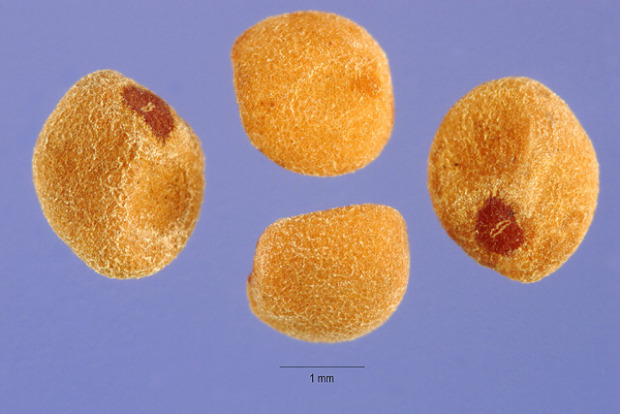
Fruit Type and Description: A tiny, rounded orange-yellow capsule about 3mm long (5).
Seed Description: The seeds are bright orange, globose, and about 1.5mm long. There are generally 4 seeds within each capsule (2,5).
Dispersal Syndrome: Seeds of C. gronovii are dispersed via water, gravity, and human activity (10).
Distinguished by: The most distinctive feature of Cuscuta gronovii is the color and thickness of the stem. The stem is coarse, about 2mm in width, and bright orange-yellow. Most other species of Cuscuta have finer stems that are only about 1mm wide. C. gronovii also is known for tiny yellow dots on any part of the plant, which are glandular secretions, in addition to warty flowers, unlike most other Cuscuta species (1, 12). Polygonum cilinode might be mistaken as C. gronovii because of the similar flowers (small and white) and flowering times, and the stem of P. cilinode is tinted red. However, the stem of P. cilinode is more red and not orange like C. gronovii, and the flowers are larger than in Cuscuta. The leaves of Polygonum cilinode are large and visible, whereas Cuscuta gronovii does not have noticeable leaves: they are just tiny scales.
Polygonum sagittatum and Polygonum hydropiperoides also are similar to Cuscuta in that the flowers are small and white, they have similar flowering times, and they live in swampy areas. C. gronovii can be distinguished because of the orange stem and the lack of obvious leaves. Cuscuta gronovii flowers are smaller than the flowers of P. sagittatum and P. hydropiperoides. Polygonum amphibium might also be confused with C. gronovii because it lives in swamps and also has a reddish-orange stem. The flowers of P. amphibium are dark pink and larger than the flowers of C. gronovii. The large leaves of P. amphibium also distinguish it from C. gronovi. (4). Ipomoea and Convolvulus may be confused with Cuscuta because they are all herbaceous vines with thin stems that twine left to right. Many species of Ipomoea and Convolvulus have white flowers, have similar flowering times, and reside in disturbed areas like roadsides and meadows, like Cuscuta. However, Cuscuta can be distinguished from Morning Glories by the lack of obvious leaves, orange stem, and small, rounded flowers. Ipomoea and Convolvulus tend to have large, showy flowers and large, heart-shaped leaves (1).
Other members of the family in Michigan (number species): Cuscuta (9), Ipomoea (4), Convolvulus (1), Calystegia (4) (sources 1,7).
Ethnobotanical Uses: Cuscuta gronovii can be used as a dye (yellow, gold, green), or it can be used for medicinal purposes to treat muscle pain or rheumatism (6). The whole plant is used.
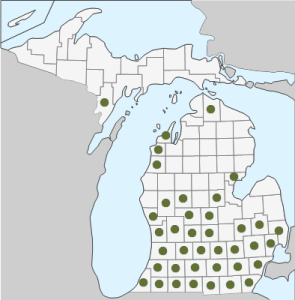 Phylogenetic Information: Convolvulaceae consists of 55 genera, while if treated as a separate family, Cuscutaceae consists of one genus – Cuscuta. Convolvulaceae and Cuscutaceae are both classified as part of Euasterids I and are part of the Solanales order. Solanales belong to the Asterid clade. Solanales contains 5-6 families. The major families included are the Solanaceae and Convolvulaceae, including Cuscutaceae (13).
Phylogenetic Information: Convolvulaceae consists of 55 genera, while if treated as a separate family, Cuscutaceae consists of one genus – Cuscuta. Convolvulaceae and Cuscutaceae are both classified as part of Euasterids I and are part of the Solanales order. Solanales belong to the Asterid clade. Solanales contains 5-6 families. The major families included are the Solanaceae and Convolvulaceae, including Cuscutaceae (13).
Interesting Quotation or Other Interesting Factoid not inserted above:
C. gronovii is a parasitic plant that has a limited ability to photosynthesize (see vegetative description) (17). Cranberry plants are significant hosts to Cuscuta. Cuscuta is largely responsible for deterring healthy cranberry growth. This frustrates cranberry harvesters because there is no easy way to exterminate infestations of the parasitic plant. These infestations can reduce crop yield up to 50% (10).
Literature and websites used:
- Voss, E.G. 2004. Michigan Flora Part III: Dicots Concluded. Ann Arbor, Michigan, USA: Cranbrook Institute of Science.
- Fernald, M. L. 1950. Gray’s Manual of Botany, 8th ed. New York, USA: American Book Company.
- USDA, NRCS. 2008. The PLANTS Database, Version 3.1, National Plant Data Center, Baton Rouge, LA 70874-4490 USA. http://plants.usda.gov/ (Jan. 18, 2011)
- Janet Novak. Connecticut Botanical Society. 2005. Last modified: 2008. http://www.ct-botanical-society.org/galleries/cuscutagron.html (Jan. 18, 2011)
- Uva, R., J.C. Neal, and J.M. DiTomaso 1997. Weeds of the Northeast. Ithaca, New York: Cornell University Press.
- Robert W. Freckmann Herbarium. University of Wisconsin – Stevens Point http://wisplants.uwsp.edu/scripts/detail.asp?SpCode=CUSGROvGRO (Jan. 21, 2011)
- USDA, ARS, National Genetic Resources Program. Germplasm Resources Information Network – (GRIN) [Online Database]. National Germplasm Resources Laboratory, Beltsville, Maryland. URL: http://www.ars-grin.gov/cgibin/npgs/html/paper.pl?language=en&chapter=scient (Jan. 21, 2011)
- Zomlefer, W.B. 1994. Guide to Flowering Plant Families. Chapel Hill, North Carolina, USA: The University of North Carolina.
- Momin, A.R. 1977. Bearing of embryological data on taxonomy of Convolvulaceae. J. Univ. Bombay 44:50-65
- Sandler, Hilary A. 2001. UMass Cranberry Station. Last modified: 2001. http://www.umass.edu/cranberry/pubs/factsheets.html (Jan. 27, 2011)
- Mathies, P.S., W.C. Holmes, A. Castanea, and A.S. Mar. 1983. The vascular flora of Cunningham Brake, a Cypress-Gum swamp in Natchitoches Parish, Louisiana. Southern Appalachian Botanical Society 48(1): 24-31.
- Musselman, L.J. 1986. The genus Cuscuta in Virginia. Castanea 51(3): 188-196.
- Judd, W.S., C.S. Campbell, E.A. Kellogg, and P.F. Stevens. 1999. Plant Systematics: A Phylogenetic Approach. Sunderland, Massachusetts, USA: Sinauer Associates, Inc.
- Reznicek, A.A., E.G. Voss, and B.S. Walters. 2011. Michigan Flora Online. University of Michigan. http://www.michiganflora.net/species.aspx?id=855. (Feb 17, 2011)
- Kral, R., A.R. Diamond Jr, S.L. Ginzbarg, C.J. Hansen, R.R. Haynes, B.R. Keener, M.G. Lelong, D.D. Spaulding and M. Woods. 2011. Alabama Plant Atlas. University of West Alabama, Livingston, Alabama. http://www.floraofalabama.org/Sponsor.aspx (Feb 17, 2011)
- Nelson. S.C. 2007. An illustrated glossary of tropical plant pest and diseases http://www.ctahr.hawaii.edu/nelsons/glossary/Dodder.htm (Feb 18, 2011)
- Funk, H.T., S. Berg, K. Krupinska, U.G. Maier, and K. Krause. 2007. Complete DNA sequences of the plastid genomes of two parasitic flowering plant species, Cuscuta reflexa and Cuscuta gronovii. BMC Plant Biology 7:45 (12 pages).
- Kuijt, J. 1969. The Biology of Parasitic Flowering Plants. University of California Press, Berkeley and Los Angeles.
- Revill, M.J.W., S. Stanley, and J.M. Hibberd 2005. Plastid genome structure and loss of photosynthetic ability in the parasitic genus Cuscuta. Journal of Experimental Botany 56(419): 2477–2486.
- National Botanical Garden of Belgium 2011 (onwards). Manual of the alien plants of Belgium. http://alienplantsbelgium.be/ Accessed 3-23-2011.
- Menges, E.S. and D.M. Waller 1983. Plant strategies in relation to elevation and light in floodplain herbs. The American Naturalist 122(4): 454-473.
- Sandler, H.A. 2010. Managing Cuscuta gronovii (Swamp Dodder) in Cranberry requires an integrated approach. Sustainability 2: 660-683.
- Clark, W.D., R. Moore, and K.R. Stern 1995. Botany. Dubuque, IA: Wm. C. Brown Publ.
- Britton, N.L. & H.A. Brown 1970. An Illustrated Flora of the Northern United States and Canada: Volume III. New York, NY: Dover Publications, Inc.
Image Credits (all used with permission):
1. Image of flower © Robert W. Smith
2. Image of habit courtesy of Janet Novak http://www.ct-botanical-society.org/galleries/cuscutagron.html Webmaster: Janet Novak, botany@indri.org
3. Image of habit © Robyn J. Burnham from the U of Michigan W. R. Taylor archival slide collection.
4. Image of fruit courtesy of Joel McNeal, Plant Biology, Southern Illinois University at Carbondale, from the Parasitic Plant Connection url: http://www.parasiticplants.siu.edu/Cuscutaceae/index.html
5. Image of seeds courtesy of Steve Hurst. ARS Systematic Botany and Mycology Laboratory. Steve Hurst @ USDA-NRCS PLANTS Database
6. Species distribution map, derived from the Michigan Flora Online.
Primary Author: Erin Regan and John Bradtke, with Parasitism section by Lauren S. Sopher, and editing by Robyn J. Burnham
© Robyn J. Burnham
For additional information on these web pages please contact Robyn J. Burnham via email: rburnham“at”umich.edu